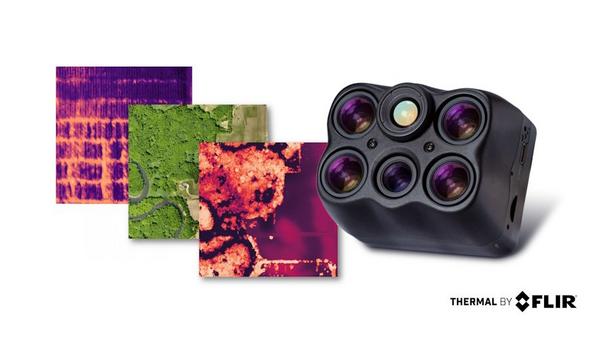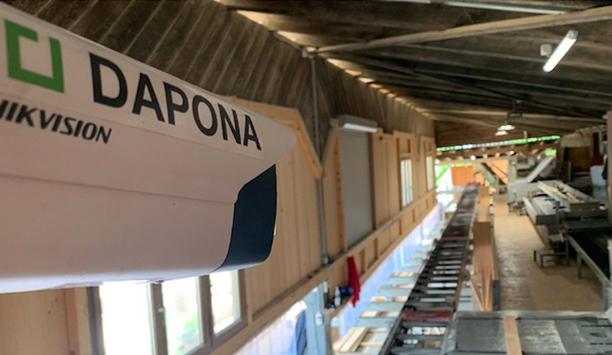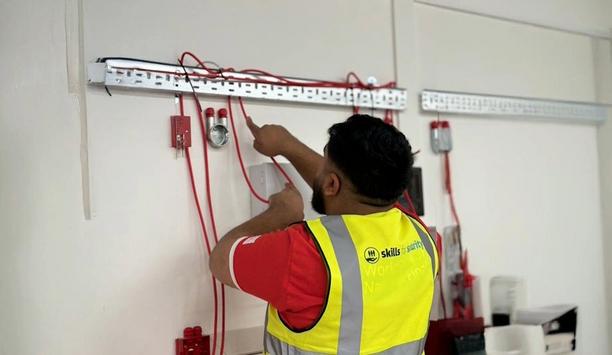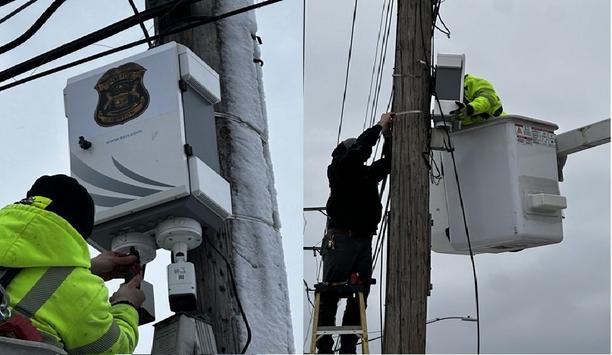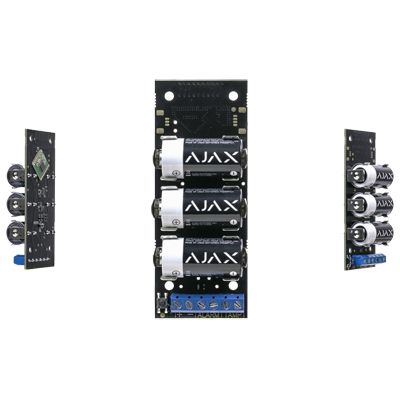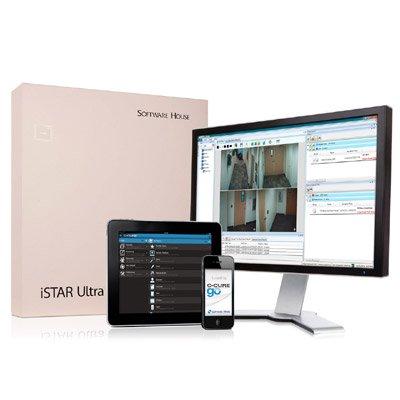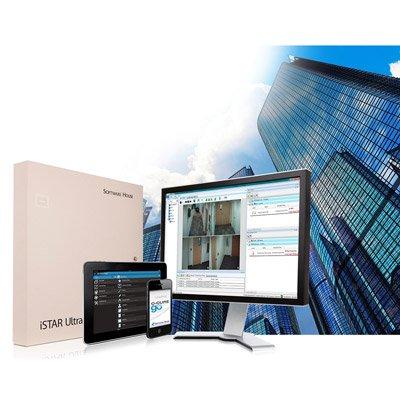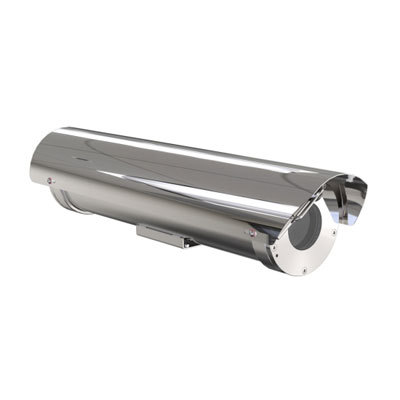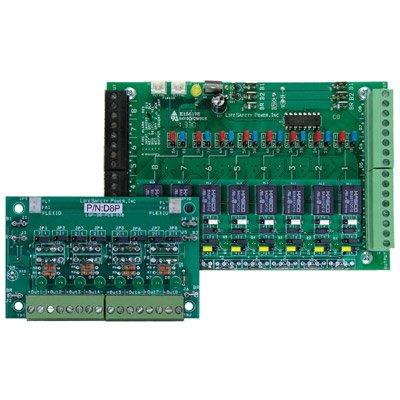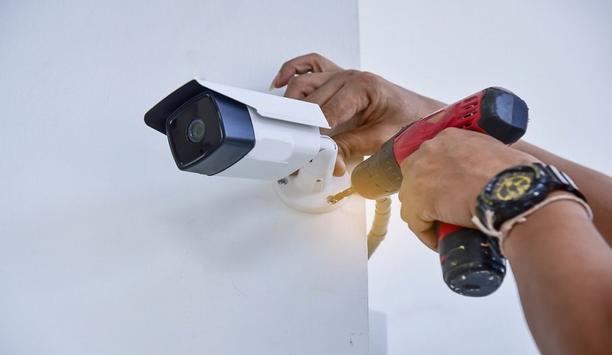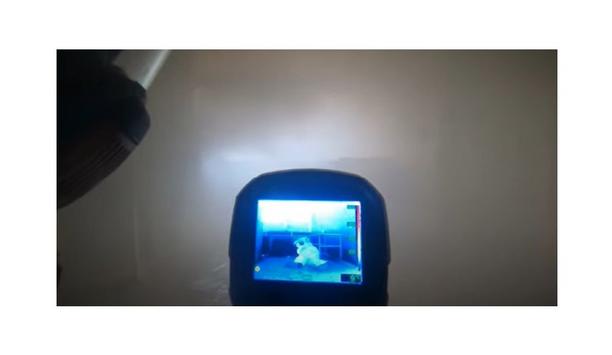Fire Safety
Johnson Controls, the pioneer for smart, healthy and sustainable buildings, is reinforcing its commitment to providing comprehensive life safety solutions across industries by unveiling solutions designed specifically for the non-acute healthcare and correctional facilities industries. The company’s non-acute bundled solution combines advanced security and fire prevention technologies to help modernise healthcare facilities, improve safety and enhance overall patient and staff experience....
Everon, a pioneer security integrator and premier provider of commercial security, fire and life safety solutions in the U.S. Announced that David Charney has joined the team as Sr. Vice President, Video Command Center. Expert in security tech With nearly 20 years of industry experience, Charney has established himself as a pioneer of innovation in cutting edge spaces. He has held key executive roles, including President, Chief Operating Officer, and most recently Chief Customer Officer for...
Teledyne FLIR OEM, part of Teledyne Technologies Incorporated, announced that Sentera Sensors and Drones, a pioneering provider of advanced sensors and data, has joined the Thermal by FLIR program. Integrating FLIR Boson® thermal camera modules into the Sentera 6X Thermal Series adds new high-precision thermal mapping capabilities to their integrated multispectral and RGB drone payload platform. Sentera 6X Thermal Series Sentera 6X Thermal Series supports agriculture, outdoor, and in...
In a powerful show of solidarity, the U.S. security industry gathered for a crucial information-sharing webcast concerning recovery efforts for the Los Angeles-area wildfires disaster. Hosted by the Security Industry Association (SIA) and coordinated by Elite Interactive Solutions Marketing Director Scott Goldfine — with official endorsements from the Electronic Security Association (ESA), The Monitoring Association (TMA) and PSA Security Network (PSA) Collaborating for wildfire re...
Hikvision has partnered with specialist Swiss real-time condition monitoring solution provider, DAPONA. The collaboration enables DAPONA to incorporate intelligent thermal cameras into their real-time condition monitoring solution, which protects industrial sites such as sawmills and wood processing companies. This enables DAPONA to further reduce the risks associated with fire, smoke, and excessive heat. DAPONA solution The DAPONA solution is a simple and intuitive cloud-based system for cr...
Ranger Fire and Security has announced its first acquisition of 2025, with McGoff & Vickers Fire & Security Systems (MGV) becoming the latest business to join the rapidly growing Ranger Group. Run by industry specialists and service business experts, Ranger brings together high-quality fire and security (F&S) businesses in partnership to share industry expertise, resources and boost cross-selling opportunities. Fire protection services North-West-based F&S business MGV has a h...
News
On March 18, 2025, members of the security industry will hear an impactful and personal assessment of the tragic and devastating wildfires upon the surrounding communities and offer the opportunity for interested industry stakeholders to discuss a potential role in the recovery efforts. This program, co-presented by the Security Industry Association, the Electronic Security Association, PSA and The Monitoring Association, is developed for information purposes and to raise awareness of current recovery efforts that may involve security strategies; it is not intended to be a platform for any endorsement of specific security products or services. Objectives Present an overview of how the impacted communities have begun to organise and develop rebuilding strategies Understand current and near-term security and life safety needs Discuss how security may be part of the infrastructure and rebuilding strategy Receive information about relevant first responder engagement and planning Intended outcome To educate the industry about the current recovery plan and to begin a process for companies to contemplate potential involvement in such efforts Featured speakers Michael Zatulov, president, Elite Interactive Solutions, and co-organiser of the Palisades Rebuild group with 2,000+ members including residents, businesses, contractors, officials and agencies Tom Stone, Los Angeles Police Department sergeant II, Metro Division, 26-year veteran; former U.S. Army sergeant major Mitch Tavera, Palisades Rebuild member; ex-police chief (39 years with El Segundo, California, Police Department) Moderated by the speaker Geoff Kohl, senior director of marketing, Security Industry Association.
Charterhouse Capital Partners, one of the longest-established private equity firms operating in Europe, announces that it has agreed to acquire ESTYA, formerly ERIS. Charterhouse will invest in partnership with ESTYA’s management, who are reinvesting in the company, and alongside Chequers Capital, who will remain a significant shareholder following an initial investment in 2021. The transaction is subject to customary regulatory approval. Electronic safety and security systems ESTYA is a French services provider specialising in electronic fire safety and security systems Founded in 1974, ESTYA, is a pioneering French services provider specialising in electronic fire safety and security systems with a comprehensive offering across electronic fire detection, smoke extraction and compartmentation, gas detection and electric security. Headquartered in Paris, the company delivers circa €120m in revenue, across 15 agencies in France, and has tripled in size since 2021, having completed seven acquisitions during that period of time. Alignment with ESTYA’s management ESTYA’s leadership, including CEO and Founder Ludovic Goëta, are committed to supporting the firm’s next stage of growth alongside Charterhouse and Chequers Capital. Through this partnership, and in alignment with ESTYA’s management, Charterhouse will apply its expertise in professionalising, internationalising, and transforming services businesses through organic growth and M&A initiatives across France and other key European geographies. Investment in ESTYA Charterhouse pursues pan-European mid-market opportunities in two core sectors of focus Charterhouse pursues pan-European mid-market opportunities in two core sectors of focus: Services and Healthcare. It targets businesses that feature ‘defensive growth’ characteristics, combining strong market positions with sustained earnings growth, with the potential for transformation. Its investment in ESTYA is closely aligned with this investment strategy, and follows recent investments in Metrodora, a pioneering Spanish education group for healthcare professionals, Skin Tech Pharma Group, a B2B medical aesthetics group, and Two Circles, a pioneering tech-enabled services and software business serving sports and entertainment clients, which were agreed in 2024. Ludovic’s long-term growth Cédric Barthélemy, Partner at Charterhouse said: “We have been following ESTYA’s journey closely for some time and have been truly impressed by what Ludovic and his team have achieved to date. As a fast-growth, high quality and resilient mid-market company, ESTYA is exactly the type of business that we like to back at Charterhouse." "We are delighted to combine our expertise in transforming local leaders in the services sector into international champions with the talented management team and Chequers Capital, to reinforce ESTYA’s pioneering market position and support Ludovic’s long-term growth ambitions.” Next stage of growth across France Ludovic Goëta, CEO and Founder at ESTYA, said: “At ESTYA, we are focused on providing mission critical services to our customers across the electronic fire safety and security system value chain." "We have grown strongly in recent years and are confident that Charterhouse is the right partner, alongside Chequers Capital, to take us into our next stage of growth across France and into new European markets.” Chequers Capital’s investment in ESTYA Aurélien Klein, Managing Partner at Chequers Capital, said: “We are pleased to have found in Charterhouse the right partners to continue Chequers Capital’s investment in ESTYA." "ESTYA has grown significantly since we first invested in 2021 and we look forward to working hand in hand with Charterhouse to grow the business further in France and internationally.”
Everon, a pioneering security integrator and premier provider of commercial security, fire and life safety solutions in the U.S., announced that Bobby Dale has joined the executive leadership team in the role of Chief Customer Officer. With over 40 years of sales and executive leadership experience in the industry, Dale is a seasoned commercial security veteran. He previously served in prominent roles at Protection 1, ADT, and ADT Commercial. Prior roles of Dale Dale will lead Everon’s efforts to gird its customer-centric approach, ensuring that the needs of clients As Chief Customer Officer, Dale will lead Everon’s efforts to strengthen its customer-centric approach, ensuring that the needs of customers are central to the company's decision-making and strategy. He will work closely with Everon’s National Account organisation and the company's entire customer base, fostering deeper partnerships across various industries and reinforcing Everon’s commitment to quality and consistency nationwide. Vision for Everon’s future “We’ve created this new role to demonstrate our commitment to enhancing the customer experience at the highest level, and we couldn’t be more excited to have Bobby in this position,” said Tim Whall, Chairman of the Board and Interim Chief Executive Officer of Everon. “Bobby has been an exceptional pioneer and a staunch advocate for customers for decades. In an industry where service quality is a key differentiator, his dedication to excellence aligns perfectly with our vision for Everon’s future and the customer experience we aim to deliver." Elevating Everon’s reputation Whall added: "His relationship-building skills are unmatched, and his deep industry knowledge will be invaluable as we continue to grow and serve our customers across the country.” “I’m truly honoured to join Everon during this exciting time and to play a part in shaping the customer experience at every level,” said Dale. “I’m committed to further fostering our culture of excellence and elevating Everon’s reputation to be synonymous with outstanding service.”
Telguard, a pioneer in security and life safety technologies, is pleased to bring to market the latest addition to its multi-carrier family of products. The new TG-7FEM multi-carrier 5G LTE-M and Internet commercial fire communicator offers the best in alarm communications. Telguard’s recent introduction The Internet can be set as the primary path, backup to cellular, or disabled Like Telguard’s most recent introduction, the TG-7FM, the TG-7FEM harnesses groundbreaking multi-carrier capability with AT&T, T-Mobile, and Verizon all built in. It continually checks service, enabling the carrier to be automatically switched if an outage is detected. What differentiates the TG-7FEM is its added ability to connect to a facility’s Ethernet LAN, providing a dual pathway for alarm signal transmission from the premises to the central monitoring station. The Internet can be set as the primary path, backup to cellular, or disabled. 5G-LTE-M technology The TG-7FEM easily connects to the panel DACT (dialer) to replace expensive landlines and communicates using 5G-LTE-M technology to ensure uninterrupted signal and product longevity. And users can opt to send signals to any central station they choose. It operates on 12/24-volt DC panel power or via AC outlet and complies with NFPA 72. The TG-7FEM is the one communicator that’s perfect for every job and offers more redundancy at an economical cost, in a UL Listed device.
Euralarm has published a new guideline on contracting cloud services for secure remote access to alarm systems and for secure alarm transmission. The guideline provides a description of important concepts related to cloud services, considers relevant standards and provides an overview of the legal criteria for the choice of a cloud service provider. IP-based alarm transmission Anyone who looks around in everyday life will soon realise that cloud services have become an indispensable part of life. This development is also happening in the world of fire safety and security. It is becoming more commonplace to use the latest technology to provide IP-based alarm transmission and remote access to fire safety systems and/or security systems (FSSS) and as such locate part of the equipment outside of the premises of the FSSS service provider. This poses special challenges for companies. New guideline of Euralarm Guidance is given for two specific use cases, each with their specific requirements and target audience This new guideline of Euralarm will assist FSSS service providers (e.g. installers) when utilising the services of a datacentre to house part of the equipment. Guidance is given for two specific use cases, each with their specific requirements and target audience. One use case is alarm transmission via an Alarm Transmission System (ATS) operated and managed by an Alarm Transmission Service Provider (ATSP) for which availability, transmission time, fault reporting and protection against substitution are key features. Remote access to the FSSS Another use case is remote access to the FSSS via a Remote Access Infrastructure (RAI) operated and managed by a Remote Access Infrastructure Service Provider (RAISP) for which secured access to the FSSS and data are key features, while availability is for convenience only. Although the guideline provides a lot of information on cloud services, the guideline does not purport to address all legislative requirements of individual countries within Europe. Care should be taken to consider the guideline in the context of any local legislative requirements which take precedence.
Skills for Security has continued its collaboration with WorldSkills UK for the 2025 season, announcing the Electronic Security and Fire competitions will be merged into a single category. This strategic move aims to enhance the competition’s impact, broadening the scope for participants to demonstrate expertise in both electronic security and fire safety systems. By integrating these two crucial areas, the competition better mirrors the evolving demands, ensuring future professionals are equipped with comprehensive skills to meet industry needs. Integrated fire safety and security Says Darrell Gilmour, Director of Technical Training at Skills for Security: “By combining the Electronic Security and Fire competitions, we are ensuring that competitors develop a well-rounded skill set that reflects today’s integrated fire safety and security industry. We believe this evolution will benefit both competitors and the sector as a whole.” Applications for the competition will open at 9:00 AM on 3rd March 2025 and close on 17th March 2025. The National Qualifiers will be held at The Security Event (TSE) on the Skills for Security stand (5/D130) across three dates, bringing together 36 of the most talented competitors from across the UK. Range of training opportunities Skills for Security will also be actively engaging with attendees at the key industry event Skills for Security will also be actively engaging with attendees at the key industry event, highlighting the wide range of training opportunities and initiatives available to support talent development within the fire safety and security sector. David Scott, Managing Director of Skills for Security, added: “It is always a pleasure to host the competition qualifiers at The Security Event, where we can demonstrate the incredible skills and talent emerging." Next generation of security professionals Scott added: "Skills for Security remains committed to nurturing the next generation of security professionals, and this competition is a real opportunity to highlight the importance of continuous training and development in our sector.” The competition is sponsored by the CSL Group, The Security Event and Texecom. With additional support from Eaton, Yuasa Battery, NSI, SSAIB, Fenix Monitoring, Honeywell and Dahua, all of whom are dedicated to supporting excellence and innovation within the fire safety and security sector. The Security Event is taking place 8 – 10 April at NEC Birmingham.


Expert commentary
Daniel May of Consort reviews the integration of access control systems in healthcare settings, outlining the benefits and key considerations decision-makers must make throughout product specifications. From patient safety and traversal to the protection of sensitive data and pharmaceuticals, healthcare environments are faced with several operational challenges. And where security remains at the forefront of decision-making, modern access control systems may often hold the answers. Physical security systems Hospitals in particular have developed into multi-faceted spaces that house hundreds to thousands of patients, staff and visitors at any one time. In England for example, research has found in the three months leading to June 2023, an average of 44,626 people visited major hospital A&E departments each day, with over 16 million attendances typically recorded over the course of a year-not to mention an additional nine million logged at other minor units. For any building, this level of sustained footfall can request severe security difficulties For any building, this level of sustained footfall can invite severe security tests. With that, the need to deploy effective physical security systems in healthcare is clear. And so, as access control continues to become more readily adopted and new products enter the market, decision-makers are reminded to consider the requirements of their building, ensuring they select the solutions most suited to their settings and budget. Security controlled Patient safety will always remain the top priority in healthcare settings, and where matters of health and social care come into question, a diverse set of professional regulatory bodies are tasked with setting and maintaining high standards. When it comes to healthcare premises specifically, patient security and perimeter security often come hand in hand and are amongst the most pressing of challenges that decision-makers must face. To help address operational planning and potential design concerns in the NHS, the Health Building Note (HBN), provides general design guidance for healthcare buildings under HBN 00-01-citing the use of access control measures as a way of maintaining security and protecting the safety of patients, staff and visitors. Use of access control Hospital buildings control varied levels of access for a number of security purposes Hospital buildings, for example, must control varied levels of access for a number of operational and security purposes. Routine scenarios exist where vulnerable patients are under monitoring and thus refrained from exiting the premises for their own safety, while at the same time, permitted staff must be able to reach their patients and medicines when required. For this, the use of access control is key. Equally, access credentials can also help management teams keep track of those who may be entering or exiting rooms with equipment and pharmaceutical supplies, deterring any unwanted visitors and opportunists in the process. Incorporation of access control systems On a similar note, regulations have set a minimum standard for how personal data should be stored and managed in healthcare environments, giving decision-makers an added responsibility to regulate staff-controlled areas with patient medical records. While instances of personal data breaches are rare, healthcare facilities and professionals are at legal risk should confidential data be found misused or missing. As such, the incorporation of access control systems has become essential in keeping data storage areas secure, with intuitive online systems capable of permitting access to staff with the correct credentials while simultaneously tracking who has requested clearance at digital entry points. HBN guidance Healthcare experts are better fitted to control the sheer volume of people entering and exiting To function effectively, healthcare facilities must always be perceived as safe places by the people who reside within them, and as HBN guidance implies, a unified physical security system can help address key safety and security concerns while enhancing patient and staff experience. Opportunely, access control systems are more accessible and adaptable than ever and combine several technologies such as mechanical locks and automatic doors with electronic access credentials in the form of smartphone apps, badge readers and biometric scanners. By integrating these systems into the building’s existing infrastructure, healthcare professionals are better equipped to control the sheer volume of people entering and exiting the premises without impairing the general flow of movement and coordination around the facility. Better by design Despite the clear benefits offered to healthcare facilities, there are a number of considerations to be mindful of when choosing an access control solution. Poorly implemented systems can have an adverse effect on security and functionality - quickly costing healthcare organisations time and budget to rectify and replace the inadequate products that don’t meet the building’s requirements. For that reason, decision-makers and design teams are reminded that there is no single solution that fits all healthcare buildings. As such, it’s crucial for decision-makers to understand the systems that are being put in place throughout each of the touchpoints in their facility. Clear collaboration is required during periods of specification, where together, teams can ensure the selected product works on all angles, from meeting fire safety and sustainability standards to aesthetics and scalability. Modern access control products Scalability is a key area that decision-makers must review when selecting access control systemsFrequently overlooked, scalability is a key area that decision-makers must review when selecting access control systems. Such is their diverse nature; healthcare facilities can often change and develop as years go by, and by selecting a system that facilitates growth, such as a cloud-based solution-security and efficiency is long-established. While modern access control products are known for seamless integration, there are some systems that may restrict the ability to use different vendors throughout the remainder of the building’s infrastructure. This, in effect, causes a monopolisation of products throughout the estate, which can have an adverse effect on growth by increasing costs and reducing the levels of service associated with the security system already in place. Improve security and safety A scalable and reliable access control system will continue to improve security and safety by adapting to a building’s new requirements-and all while having minimal impact on its operational network. And so, while technology will no doubt continue to influence and transform the access control market, healthcare facilities and their professionals must continue to remain educated on their own systems, ensuring they have the best options in place to keep their patients, staff and visitors safe and secure for years to come.
Where access control is concerned, architects and design teams must find the right balance between aesthetics, functionality and security, says Daniel May of Consort Architectural Hardware. Following a period of innovation and integration, access control has developed into an ever-prominent facet of building design over the past decade. Where systems were once rudimentary, modern user requirements have led to several operational and technological advancements, resulting in a versatile selection of options that move beyond the limited capabilities of centralised deployment architecture. Growing market demand The push for smarter buildings has played its part too. In fact, according to a 2022 report, the number of smart buildings worldwide is projected to climb from 45 million to 115 million by 2026, with global market size estimated to hit $201.16 billion by 2031 - and this growth shows no signs of slowing down (omitting another global pandemic). The number of smart buildings worldwide is projected to climb from 45 million to 115 million by 2026 In order to meet growing market demand, manufacturers continue to modernise access control solutions, introducing the use of mobile credentials, cloud control and even bio-metric systems. As such, the specification process for access control hardware continues to become more nuanced, and for architects in particular, there’s an increasing challenge to ensure all design objectives are met. With this in mind, how can professionals strike a balance between seamless integration and design? Modern hotel environments For many decision makers, access control is viewed as an efficient and flexible route to securing their building. But more than that, it has become critical to the operative performance of our built environment, where from residential settings to commercial space, the adopted use of interconnected systems is further boosting accessibility, functionality and security. Take modern hotel environments for example. According to a 2022 report, 56% of hospitality consumers expressed locking and unlocking rooms using biometrics and facial recognition would enhance their experience. From Wi-Fi infrastructures to cloud services, technology has almost become synonymous with a hotel guest’s experience and is designed to improve their stay. Where digital access control systems are adopted, guests can interact with the premises independently, streamlining their access to essential entry points while safeguarding rooms against unauthorised visitors. Hotel operators benefit from enhanced building security and increased traceability Higher guest ratings Similarly, hotel operators benefit from enhanced building security and increased traceability, not to mention improved business efficiency and higher guest ratings. Ultimately, better-quality aesthetics enhance environments by making them more welcoming However, while security and accessibility are frequently top of the agenda when it comes to specifying hardware, from an architectural perspective, a solution’s aesthetic is just as valuable and plays a crucial role in the decision-making process. Often, door hardware can feel like the finishing touch to a design project, and so, careful consideration must go into consistent design choices that make a positive impact on the building’s aesthetic. Ultimately, better-quality aesthetics enhance environments by making them more welcoming. Access control systems Again, hospitality is a good case in point, where hotels must ensure their environment is visually pleasing as part of the service quality offered to their guests. However, a survey on urban design revealed 40% of architects find incorporating security measures into new developments without impacting aesthetic appeal a key design challenge. With this in mind, architects and design teams can be forgiven for past frustration towards the unattractive and cumbersome access control systems that were once in their infancy. In reality, today’s systems offer a much more seamless design, and with end users placing value on key elements such as accessibility, fire safety and reliability, it’s now possible to incorporate a solution that works for everyone. Hospitality is a good case in point, where hotels must ensure their environment is visually pleasing Combining value and visuals Upon recognising today’s access control systems promote functionality and seamless installation without compromising aesthetics, there’s a growing demand for comprehensive, single-package solutions across many contemporary projects. As a result, architects and designers are increasingly met with questions on door hardware and access control and must keep up to date with the latest solutions that are available. Architects and designers are increasingly met with questions on door hardware and access control As such, the initial design stage provides an opportune period for architectural teams to consider the needs of the end user in relation to access control systems. From a building’s security elements to its flow of movement, there are various objectives to reflect upon, and architects must look to develop their knowledge on access control solutions to ensure all end user objectives are met, and all while considering the final aesthetic. Access control solutions Naturally, projects can often benefit from greater collaboration and architectural professionals are urged to lean on the expertise of manufacturers where required. By working closely with trusted manufacturers early in the process, teams can incorporate the latest technology into buildings at the initial stages of design, as opposed to being an addition later in the process. Teams can incorporate the latest technology into buildings at the initial stages of design In many cases, manufacturers now offer bespoke access control solutions too, each designed to adapt around the end user’s needs while working with the architect on a design level. Through greater collaboration and the use of tailored solutions, architects are given the ability to choose consistent finishes and materials that fit the planned aesthetic, removing the need to try and match across various suppliers later down the line. Introducing tailored solutions Seemingly, access control will continue to play a larger role in building design as the industry progresses. And while the adoption of new technology may inherit an element of uncertainty for some, by introducing tailored solutions with seamless integration at early stages of the design process, architects can rest assured that their proposals address core challenges such as security and fire safety, while keeping their aesthetic vision intact.
A study found that over 80% of smartphones have biometric protection enabled, up from 68% a few years ago - these statistics alone show the trajectory of biometric security solutions. In the world of access control systems, biometric advancements allow for more secure authentication measures and seamless security processes. As more products and services hit the market, learn our predictions for the 2023 biometric trends in this article. Biometric access control systems What are biometric access control systems? Biometric access control systems include safety measures like facial and fingerprint recognition, as well as multi factor identification terminals. These systems decide who is authorised to enter a specific room, floor or even the entire building, using a database of stored identifiable features, like someone’s fingerprints. If an individual tries to enter and is not in the system, then they are denied access. Biometric Access Control Trends to Look Out For in 2023 - From multifactor authentication to contactless security measures, discover the five biggest upcoming trends in biometrics for access control. Real-time facial recognition The cloud has offered us new and innovative ways to store vast amounts of data Cloud Biometrics - The cloud has offered us new and innovative ways to store vast amounts of data. Combined with biometrics, this trend will allow security professionals to forgo the dedicated server and store their data on the cloud. Cloud biometrics facilitate real-time facial recognition and other processing-intensive security measures. It even allows for remote monitoring, which will be essential in our new era of hybrid working. Multifactor Authentication - In 2023, multifactor authentication will become the norm. It is already widely used by people to secure their accounts, but it will be vital in access control security. Multifactor authentication adds another layer of security by combining a traditional password with facial recognition or fingerprint biometrics. This approach has previously been reserved for highly sensitive data, but with cybercrimes on the rise, it will soon be used to protect everyday accounts. Highly sensitive data Contactless Biometrics - The most recent advancements in biometrics allow people to go about their day without being interrupted by pin codes and touchpads. Contactless biometrics, combined with integrated systems and algorithms, allow people to move seamlessly without sacrificing security. The latest biometrics, for example, can let a pre-authorised individual into a building, inform the appropriate people that they have arrived and call them an elevator, all without needing to touch a keypad. They care about security, but people also want to trust that their provider shares their values Ethical Biometrics - Increasingly, people are valuing ethical biometrics. They care about security, but people also want to trust that their provider shares their values. People want to know that their data will be protected, in line with privacy laws, and that the biometrics system they use will be unbiased. This new standard for the industry has been growing steadily, but 2023 will bring stricter expectations for ethical security. Digital IDs - More people than ever are using digital IDs. From the humble digital wallet, which we all have on our phones, to more complex applications used in access control, physical cards are seemingly a thing of the past. This shift has required (and will continue to require) a complete overhaul of existing infrastructure to allow for new forms of identification. TLDR: 2023 biometric trends in access control The latest biometric trends will see contactless security measures become the norm. With advancements in cloud biometrics and digital IDs, the latest technologies will continue to allow for new and innovative security solutions. However, with stricter expectations for ethical biometrics and data privacy, any new security trends will need to align with these standards. As the founder of Elite Security, Ben McCayna is passionate about security. He started the company in 2004 after identifying a need for high-quality door and security installations and specialised maintenance for commercial businesses. Ben is one of the leading security experts in London and beyond, thanks to his highly successful company and network of happy clients. Elite Security has grown to offer a wide range of security and access control systems, including fire safety, intercoms, alarms and CCTV. With decades of experience in both business management and security, Ben has established himself as a true expert in his field.
Security beat
IFSEC International took place over three days at the ExCel in London, presented alongside shows covering fire safety, intelligent buildings, facilities management, and safety and health. While perhaps not on the same scale as pre-pandemic events, the atmosphere was convivial and spirits high, everyone glad to be back amongst their peers in the industry. Predictably, the trending topics were steered by issues in the wider world: sustainability, moving services to a subscription-based model, and new ways of working inspired by COVID-19 safety measures. A place for cutting-edge innovation After a challenging couple of years, companies were keen to meet customers, showcase their products and reveal the latest innovations. Integrated Design Limited displayed their new Glassgate 400 Plus turnstile, a sleek design for the corporate market. Tony Smith, Major Accounts and Marketing Manager, Entrance Control and Turnstile Security, told SourceSecurity.com, “I feel trade shows are a very important part of IDL’s marketing effort. We are more than pleased to display alongside our peers and have customers make direct comparisons with our products and theirs.” Biometric access reader Biometrics, as ever, generated a lot of interest, including the European launch of RealNetworks’ new SAFR SCAN biometric access reader, which combines facial recognition, computer vision, and image capture technologies for a range of applications. “Overall, there was a really good footfall, and we met an excellent mixture of end-customers, system integrators, distributors, and consultants from both Europe and the Middle East who are exactly the types of people we were hoping to demonstrate SAFR SCAN to,” commented Charlie Bennett, Vice President UK & Europe – SAFR, RealNetworks. Access control systems going green HID Global is one company leading the way in the move away from plastics to focus on mobile access The eco-friendly trend and the need to be more sustainable is becoming a real force in the security industry, particularly in access control where there is considerable pressure to ditch the plastic. HID Global is one company leading the way in the move away from plastics to focus on mobile access. Gerald Grattoni, Physical Access Control Solutions Regional Business Unit Vice President at HID Global (part of the ASSA ABLOY Group), explained in a press briefing, “Making buildings smarter and more eco-conscious is high on the corporate responsibility agenda of many companies as the sustainability credentials of new buildings are now very important. With digitalised mobile identities there is less plastic waste and lower emissions.” Flexible, remote, and contactless Innovation in smart buildings is also being led by changes to how we work, live, and play, inspired in part by the recent pandemic. New technology is required to meet the needs of the hybrid workspace, as employers adopt more flexible working models and demand for contactless access control increases. Now, the most technologically sophisticated buildings are controlled by an app on a mobile phone, giving ease of access and full control without the need for plastic cards. Remote monitoring Advances in remote monitoring have escalated due to COVID-19, particularly in high demand in the health and education markets. Connecting via industrial standard network protocols allows for remote communication Ian Bridgewater, Director, Technical Sales Manager, TOA Corporation (UK) Ltd, explained further, “Connecting via industrial standard network protocols allows for remote communication. Working with specialist software developers has expanded this, giving greater flexibility to monitor and maintain systems remotely from a central hub.” AI-based autonomous access solution AI also has a role to play in this new high-tech, touchless world and various companies are utilising this technology. Alcatraz AI found IFSEC the perfect opportunity to exhibit their new Rock autonomous access solution. "We now live in a time in which AI can make precise real-time decisions at the door to authenticate or deny access using your face as a credential,” said Greg Sarrail, Senior Vice President of Sales at Alcatraz AI. “IFSEC 2022 allowed Alcatraz AI to demonstrate the speed and accuracy of autonomous access control. The number of qualified partners and end-users representing a broad international scope in attendance at IFSEC was encouraging.” Meanwhile, the Eagle Eye Networks stand attracted a lot of visitors keen for a demo of their new Eagle Eye Smart Video Search, which allows users to search for people, vehicles, or objects, and immediately find the exact video across all cameras in all sites. "AI and cloud are two trends that Eagle Eye, the media, and the security business community have been talking about for a while. We were excited to showcase Eagle Eye's new AI-powered technologies at IFSEC 2022," added Rishi Lodhia, Eagle Eye Networks Vice President and Manager Director EMEA. "Our stand was buzzing with activity and AI was the main topic of discussion for all three days. All in all, a great show." Investing in a secure future Engineers of Tomorrow gave apprentice finalists the chance to show off their skills in front of thousands of peers and professionals from the security sectors live on the show floor. The winners will go on to the WorldSkills UK (WSUK) LIVE competition – the nation’s premier skills, apprenticeships, and careers event. Although the products on display at IFSEC promised a contactless, digital future, this was a good reminder of the importance of the people who install and maintain these systems and the vital role of engineering apprenticeships in the industry.
Convergint Technologies’ rapid growth has come through a combination of organic growth and acquisitions — they have acquired 35 companies since 2014. Growth has been a focus since day one when the founders started the systems integration company with 10 colleagues in a basement. Today, the diverse company includes more than 5,000 employees globally. As technology has advanced and business practices have evolved, Convergint’s core values and beliefs have guided their path forward. Customer-centric approach Convergint’s culture is a critical aspect of the company, from the executive level to frontline colleagues. “It is essential that the companies we look to acquire and develop partnerships with directly align with our people-first, customer-centric, inclusive culture centered on colleagues and customers,” says Mike Mathes, Executive Vice President, Convergint Technologies. “This approach has allowed us to maintain and grow our number of colleagues across our acquisitions and enables us to continue being our customers’ best service provider.” Integration practices Many practices have to be form-fitted to each individual acquisition A simple but important consideration as Convergint grows through acquisitions is: No two companies are the same. While some integration practices can be standardised across the company, many practices have to be form-fitted to each individual acquisition, says Mathes. “Our objective is not to come in and immediately implement change. We want to build on what has already been successful within the local market and share our learned experiences. There is plenty we can learn from each other and create a much better organisation.” Mathes says that Convergint’s view of a successful acquisition is that 1+1=3. “The end result is always much more impactful than what we anticipated,” he says. “Every acquisition brings with it an experienced leadership team, dedicated and skilled colleagues, vertical market and technological expertise. Most acquisitions are in geographies where we do not already operate, so with every acquisition, we increase our capability to serve our customers much better.” Also, the network of Global Convergint Technology Centres (CTCs) helps expand clientele, and the Convergint Development Centre (CDC) offers new support capabilities allowing acquisitions to grow at a very high rate. Expanding service Are there more acquisitions to come? Mathes says Convergint is always open to further expanding its footprint across the globe, improving its ability to service customers, deepening their technical expertise, and continuing to expand service offerings across the current and new vertical markets. However, the current focus remains on several key factors: service to colleagues, customers, and communities. “While obviously, acquisitions fuel our growth, the addition of these organisations to Convergint has really improved our ability to service clients on a global basis,” says Mathes. Acquiring ICD Security Solutions in Asia, for example, made Convergint a pioneer in that market for U.S.-based multi-national companies. Meeting customers demand “Convergint does not weigh market conditions when making an acquisition decision,” says Mathes. Rather, they are primarily focused on meeting or exceeding their customer’s needs on a local to a global level. They see acquisitions as a potential way to extend their geographic reach so they can be closer to customers. An acquisition might also expand technological or vertical market expertise. “The end goal is for us to enhance our service capabilities by attracting and retaining talented colleagues and leaders to better service our customers,” says Mathes. Enhancing and expanding services Convergint identifies how to leverage the expertise to further enhance and expand current service options “Economies of scale” have not been a consideration. They have never sought to acquire companies and restructure them in the process, for example. Rather, each company brings forth a unique skillset, is carefully vetted by the executive team, and provides purpose in the company's mission and vision for the future.” “Frontline colleagues are Convergint’s most valuable assets,” says Mathes. Rather than restructuring and eliminating skilled, knowledgeable colleagues, Convergint identifies how they can leverage the expertise to further enhance and expand current service options for customers. “Our colleagues and their skill sets are our competitive advantage—they remain an essential element to our success,” says Mathes. Demand for integrator services “We continue to experience a growing demand for innovative solutions across electronic security, fire alarm, and life safety,” says Mathes. “As companies innovate further and rely on technologies such as artificial intelligence, cybersecurity, IoT, and cloud solutions, we expect to see an increased demand for integrator services. Our customers demand a local service provider who is responsive and can meet their needs, which is why Convergint aims to be its customers’ best service provider.” This year, Convergint is celebrating its 20th anniversary. In 2021, they will continue to focus on the same critical components that have dominated since day one taking care of colleagues, customers, and the communities where they operate.
The COVID-19 pandemic has provided a double challenge to physical security systems integrators. For one thing, they have had to adapt their own businesses to survive and thrive during the pandemic. On the other hand, they have also been faced with new challenges to serve their customer’s changing needs. Global pandemic effects One integrator company, North American Video (NAV) took the now-familiar steps most companies confronted to adapt their business model to operations in a global pandemic – they suspended all non-essential travel and face-to-face meetings. At one point, NAV had a single employee in the New Jersey headquarters and another one in the Las Vegas office. The rest worked from home, with other offices opening as needed over the following weeks. Another integrator, Convergint Technologies, was able to adapt its approach to the pandemic, location by location, across the United States. The integrator benefitted from its leadership structure, with local managers in various regions who are autonomous and could react to what was happening in each region. Virtual workforce “We saw a dip in April and May, but since then, we have seen business pick back up,” said Mike Mathes, Executive Vice President, Convergint Technologies. The Business of Integration virtual conference sponsored by the Security Industry Association (SIA) “We already had tools and infrastructure deployed to support a virtual workforce. We had the software and the right equipment, and that has allowed us some flexibility to approach the repopulation of our offices in a gradual way.” The impact of COVID-19 on integrators and their customers was the main topic of discussion at a session on The Business of Integration at the Securing New Ground virtual conference sponsored by the Security Industry Association (SIA). Remote monitoring North American Video also benefitted from having technical personnel spread across the United States. By assigning work duties on the basis of geography, they could travel by car with less risk than air travel. They also increased their use of remote monitoring and support to avoid extra visits to customer sites. With 80% of the business in the gaming industry, North American Video saw a profound impact on their customers with the almost complete shutdown of casinos during the early days of the pandemic. Even though gaming was impacted particularly badly by the virus, NAV stayed engaged working on four or five large casino construction projects that continued throughout the shutdown. Revenue shortfalls State legislatures will approve more casinos to help plug the holes in their budgets Other casinos took advantage of empty facilities to make needed upgrades without worrying about disrupting casino operations. “A lot of our strong, long-term clients have sought to perform upgrades during the downtime, including needed service and maintenance,” said Jason Oakley, President and CEO, North American Video (NAV). “When gaming was closed, you were allowed in the facilities to work.” Oakley also sees long-term optimism for the casino business, which will offer a means for state and local governments to make up revenue shortfalls. “State legislatures will approve more casinos to help plug the holes in their budgets,” Oakley predicted. Demands for technology Oakley and NAV have seen an evolution in customer demands for technology in light of the pandemic. The trick is to differentiate between demand that is an immediate reaction versus technology trends that have more staying power. Although customers were keen on purchasing thermal cameras, for example, NAV did the research and recommended against the use of the technology to some of their customers. Artificial Intelligence for social distancing The use of artificial intelligence (AI) for a variety of applications seems to have more staying power. “One area of interest at a high level is modification and repurposing of AI for face mask detection, social distancing and people tracing, including integration into existing cameras,” said Oakley. “If the hospitality industry comes to terms with the new normal with smaller restaurant capacities, there may be an opportunity to use AI for social distancing.” Contact tracing and visitor management technology Mathes of Convergint sees a massive change as customers move toward managed services, accelerating the change with new use cases. We have an entire group that focuses on new solutions and what customers are looking for" As offices seek to repopulate when the pandemic subsides, customers are looking for new uses of existing technologies, added Mathes. “We have an entire group that focuses on new solutions and what customers are looking for,” he said. “They need to understand who is in the building and where they go in the building. If we know someone was only in the cafeteria from 10 to 11 a.m., we can know who was in the cafeteria at that time.” Opportunity for vertical markets to move forward He predicts technologies for contact tracing and visitor management tracking who’s in the building and where will be around for a long time to come. "Various customers and vertical markets are looking at the slowdown differently," said Mathes. "For example, while airlines have slowed down, the view from the airport market is more long-term." “They have 15-year plans, and [the slowdown] is an opportunity to move forward. In the technology space, data centres are expanding. “We try to focus our resources on areas where the money is being spent,” said Mathes. “Our K-12 group has seen an 80% growth over 2019. The money is tied to bonds, so there hasn’t been a slowdown relative to revenue.” He said Convergint is cautiously optimist about 2021.”
Case studies
ZeroEyes, the creators of the only AI-based gun detection video analytics platform that holds the full U.S. Department of Homeland Security SAFETY Act Designation, announced that its proactive gun detection and intelligent situational awareness platform has been deployed by the Modesto Police Department (PD) in strategic locations throughout the city. This partnership reflects the Modesto Police Department’s commitment to utilising the latest tools to improve public safety and reduce crime in the community. Firearms and instant alerts “We want our community members to feel secure in their work, leisure, and daily lives,” said Cat McFadon, Police Civilian Manager of Modesto PD. “ZeroEyes’ ability to detect firearms and trigger instant alerts will allow us to respond more quickly and efficiently to gun-related threats. With this additional technology in our toolbelt, we’re reinforcing our efforts to drive down crime and make Modesto a safer place for everyone.” Effectiveness of ZeroEyes technology Pilot program is intended to assess the effectiveness of ZeroEyes technology in real-world conditions Modesto, a city of 216,000 residents in Northern California, is known for its progressive law enforcement efforts. The department has a long-standing dedication to equipping its officers with the most advanced technology to support their mission to protect life and property. This pilot program is intended to assess the effectiveness of ZeroEyes technology in real-world conditions, with the goal of expanding its use in key areas such as local schools and the city’s shopping mall. ZeroEyes' AI gun detection ZeroEyes' AI gun detection and intelligent situational awareness software layers onto existing digital security cameras. If a gun is identified, images are instantly shared with the ZeroEyes Operations Centre (ZOC), the industry’s only U.S.-based, fully in-house operation centre, which is staffed 24/7/365 by specially trained military and law enforcement veterans. If these experts determine that the threat is valid, they dispatch alerts and actionable intelligence — including visual description, gun type, and last known location — to Modesto PD as quickly as 3 to 5 seconds from detection. Modesto PD’s expectations “The Modesto PD’s commitment to increasing public safety through innovative technology aligns perfectly with our mission, and we look forward to the collaboration,” said Mike Lahiff, CEO of ZeroEyes. “We’re confident that ZeroEyes will not only meet but exceed Modesto PD’s expectations, enhancing response times and reducing the impact of gun-related threats.”
There are well over 1,200 road tunnels in Norway. Camera-based incident detection is the preferred way to keep these tunnels safe and support tunnel operators in organising a fast incident response. Camera-based detection Gradually introduced since the nineties, camera-based detection is well established. Both visual and thermal imaging cameras have proven to be a fail-proof solution for 24/7 automatic incident detection inside tunnels. With the latest camera technology upgrade of the Damsgård Tunnel in Bergen, Norway is premiering AI-enhanced dual-vision cameras as a new evolution in incident detection. Damsgård Tunnel technology upgrade In 2024, the tunnel will undergo a comprehensive technology upgrade, with the replacement The Damsgård Tunnel is part of Norwegian National Road 555, which runs from Fjell to the city center of Bergen. The road tunnel opened in 1992 and has two tubes of around 2.3 kilometers in length, each carrying two lanes of traffic through the Damsgårdsfjellet mountain.In 2024, the tunnel will undergo a comprehensive technology upgrade, with the replacement of ventilation systems, lighting, drainage, and camera technology. AI-enhanced dual-vision cameras Unique to this project is that, for the first time in Norway, AI-enhanced dual-vision cameras will be used. The traffic cameras from sensor specialist FLIR combine thermal and visual imaging technology in a ruggedised housing and rely on advanced deep learning algorithms that enable the camera to detect stopped vehicles, wrong-way drivers, queues, crossing pedestrians, and even smoke and fires in their early stages. Approximately 80 FLIR cameras are scheduled for installation in the second half of the year. The history of tunnel incident detection in Norway The Damsgård tunnel upgrade is another milestone in Norway’s long-standing efforts to secure the country’s vast number of tunnels. Due to Norway’s complex landscape, with fjords, mountains, and islands, road tunnels have always been a way to solve the region’s unique transportation challenges. Norway has embraced the use of automatic incident detection in its road tunnels ever since the technology came into being, with FLIR setting the pace of this evolution since the beginning. In 1995, FLIR cameras were already used in the 1,500-meter-long Ekeberg Tunnel near Oslo. FLIR automatic incident detection system In 2004, a European directive on road tunnel safety prompted the roll-out of incident detection systems In August 1996, when a bus stopped and caught fire in that tunnel, the FLIR automatic incident detection system generated an alert to the tunnel operators, enabling them to close the tunnel entries and exits and activate warnings to oncoming motorists. In 2004, a European directive on road tunnel safety prompted the roll-out of incident detection systems in tunnels continent-wide and since then the technology evolution has not stopped. Visual and thermal incident detection Initially, visual CCTV cameras were used to detect incidents. The technology enabled first response teams to be deployed minutes, even seconds after an incident or an irregularity (a fallen object, a pedestrian, a car slowing down) was detected. About ten years ago, FLIR introduced thermal incident detection cameras in tunnels. These cameras are established as critical assets that guarantee operators' accurate detection throughout the tunnel infrastructure. 24/7 traffic detection The use of thermal imaging cameras has especially proven valuable for tunnel entrances and exits. There, shadows or direct sunlight can obstruct the view of visible-light cameras and therefore disturb traffic detection. Because thermal cameras detect heat, not light, they have no issues with these phenomena. As a result, thermal cameras can detect traffic 24/7 and in all weather conditions. Fire detection FLIR thermal cameras can also spot fires at the stage of ignition, making them the fastest One of the biggest advantages of thermal cameras in the field of tunnel safety is that they can effectively see through smoke. This makes them the ideal technology for tunnel safety operators or emergency response teams to find their way through a smoke-filled tunnel or for incident detection systems to spot issues in time. FLIR thermal cameras can also spot fires at the stage of ignition, making them the fastest and most reliable technology for fire detection inside road tunnels. The role of dual-vision cameras Both visual and thermal cameras have their merits. A visual camera may provide operators with more detail to assess the nature of an incident, while thermal cameras have proven to be unbeatable in detecting incidents in complete darkness and challenging weather conditions. Currently, both detection technologies can be combined into one system, hereby offering operators a more comprehensive view of the environment and improved accuracy compared to single-sensor systems. FLIR’s TrafiBot Dual AI camera is an example of such a combined system. ITS-Series Dual AID cameras In 2018, FLIR’s ITS-Series Dual AID cameras were installed at the entrance and exit of the Lyderhorn Tunnel near Bergen. In 2021, technology integrator Trafsys also installed 332 of FLIR’s dual-vision cameras in the Hundvåg and Eiganes tunnels, which are part of the extensive Ryfast project. The cameras’ fire detection functionality proved effective when a car fire occurred in the Hundvåg tunnel in July 2020; the FLIR ITS dual thermal AID camera detected the fire within 7 seconds of visible flames, following an initial alert for a stopped vehicle and pedestrians. Artificial Intelligence in incident detection AI algorithms embedded in the FLIR camera analyse captured images in real-time and full-resolution FLIR’s TrafiBot Dual AI, installed in the above-mentioned Damsgård Tunnel announces a new wave of incident detection cameras. The camera also combines a visual and a thermal camera in one unit, but what makes it stand out is the use of artificial intelligence and deep learning. AI algorithms embedded in the FLIR camera analyse captured images in real-time and full resolution. This latest addition to FLIR’s portfolio of AI cameras is setting a new standard for automatic incident detection in tunnels, generating extremely accurate traffic data, incident detection information, and live track data. Video image analysation Of course, analytics on traffic cameras are not new. Early cameras from decades ago already used some form of AI. So, what’s the difference with this new generation of AI cameras? Much has to do with how detection systems analyse video images. Early generations of smart cameras analysed the variation of gray levels in groups of pixels in successive video frames. Smart predictions When a vehicle enters a detection zone, the pixel value within that zone changes, and detection is activated. AI systems, however, look at the entire camera image and use object detection techniques to analyse the traffic scene. This results in much better presence detection, better classification of traffic users, and the ability to determine position, speed, and direction. These new AI systems can handle more complex traffic situations and they are much better at making smart predictions. Identification and classification of objects Computing speeds have increased, hardware prices dropped, and the exponential growth of data has worked It’s not hard to see where this is coming from. Over the past decades, computing speeds have increased, hardware prices dropped, and the exponential growth of data has worked as fuel for making AI better and more efficient. Instead of rule-based analytics—if x happens, then y—data-based systems are now in the lead. These systems can be trained on large datasets of images and learn how to identify and classify objects in an image. They use this knowledge to make decisions based on new images that they have never seen before. Benefits of AI-based detection systems AI-powered detection systems are much more accurate than their non-AI alternatives. For tunnel operators, this is a big deal. Nothing is a bigger nuisance for control room operators than having to pay attention to continuous unwanted alarms. AI can help filter out unwanted alarms by distinguishing between routine activity, weather phenomena, and actual incidents. High performance As an important aspect of their accuracy, AI-based systems are much more successful in detecting different vehicle classes. Detectors from FLIR will easily distinguish between a car and a van, or between a small and a large truck. It’s even possible to train a system to detect specific objects or incidents. And because cameras are so smart, installers nowadays are more flexible in installing their equipment. Even in less ideal camera positions, the detection performance of AI-based systems is high. Vehicle parameters Based on vehicle parameters such as speed and direction, they can easily see where a car is going FLIR’s AI detectors can also predict vehicle trajectories. Based on vehicle parameters such as speed and direction, they can easily see where a car is going, even if for part of that trajectory the view of that car is occluded by a passing truck. This makes detection much faster and more accurate. Operators can even be warned by so-called pre-alarms for cars that are slowing down and likely to cause a collision. Reduces human monitoring For traffic or security operators, AI offers many benefits. Since incidents can be detected much faster and with more accuracy, operators will be able to make better-informed decisions, especially in high-stress situations, and they will be able to deploy emergency teams more quickly. AI will also reduce the need for constant human monitoring, allowing operators to focus on other tasks.AI will benefit traffic planners too. Data collected from a camera can be analysed over time to identify trends, patterns, or areas with a higher potential for incidents. This can be valuable for proactive traffic planning, infrastructure improvements, or for overall risk management. Data as the cornerstone of AI performance AI-based detection systems will become the norm very swiftly. Since these systems depend on massive data sets, it’s easy to understand that the detection performance will soon be determined by the quality of the data it is trained with. High-performance systems will need a lot of data for training—in case video images of traffic—but not just any data that has been plucked from the internet will do. Challenges with publicly available datasets The problem with that approach is that, more often than not, publicly available datasets are limited Some camera manufacturers rely on publicly available datasets to train their AI systems. The problem with that approach is that, more often than not, these datasets are limited or of low quality. For example, internet data sets hardly have any thermal images, traffic images are mostly collected during sunny weather or friendly daytime conditions, and they are often taken from useless angles. FLIR model and prediction AI-based products from FLIR, on the other hand, are trained on datasets that have been collected in-house, over more than 30 years, with data samples that are relevant for practically any traffic scene you can think of. What’s more, FLIR’s datasets are continuously growing and with it the quality of its models and predictions. For FLIR, data is the true quality mark which stands for high-performance, accurate traffic detection. The future is AI Norway and FLIR share an interesting history of evolving incident detection technology. A lot has changed since the installation of the first FLIR automatic incident detection system in the Ekeberg tunnel in 1995. Currently, incident detection systems combine multiple sensors—visual and thermal—and, most importantly, they use AI, which enables them to improve their detection performance over time with every new video image they process. Artificial intelligence has a promising future in incident detection. Norwegian tunnels, and the average daily traffic of 40,000 vehicles in the Damsgård Tunnel, will only benefit from it.
To combat persistent retail crime and deliver peace of mind to workers in the bustling North Leroy Street business district, the City of Fenton Police Department has deployed a new AI-powered video surveillance system with camera-sharing technology to accelerate response time during retail heists or other emergencies. Deter, detect, and apprehend criminals Fenton is a small city with 12,000 permanent residents, but Chief of Police Jeffery Cross estimates that 60,000 people pass through the town daily. Located off Highway US-23, it is a popular shopping and restaurant district for commuters and people from neighbouring cities. Unfortunately, retail criminals also frequent the area. The new video surveillance system is designed to deter, detect, and apprehend retail criminals. Live security camera footage Through a partnership with RapidSOS, this technology gives Fenton’s 911 dispatch professionals immediate access The new system, housed in a rugged, weatherproof cabinet and mounted on a telephone pole with two cameras, includes Eagle Eye 911 Camera Sharing technology. Through a partnership with RapidSOS, this technology gives Fenton’s 911 dispatch professionals immediate access to view live security camera footage during an emergency. “With 911 Camera Sharing, the 911 operator can see the situation unfold and give law enforcement direct, quality information and immediate feedback about what happened and the direction the suspect is headed in,” Cross explained. “That enhances safety for first responders and our community.” Smart Video Search In addition, the security cameras have built-in AI-powered Eagle Eye Smart Video Search, which enables Fenton’s authorised law enforcement officials to quickly search security camera footage for vehicles, people, or objects of interest. “With Smart Video Search you can search for a ‘person wearing a red shirt and black pants’ a ‘blue Honda truck’ or ‘person with a backpack’ and quickly find a shoplifting suspect or determine when a certain vehicle, person, or group of people entered a shopping centre parking lot, which can be critical information for law enforcement,” said Joe Bommarito of Elite Fire Safety, a division of Sciens Building Solutions. This Novi, Mich.-based security integrator is working on the project with the City of Fenton. AI-powered video surveillance “Fenton’s new system with 911 Camera Sharing and AI features such as Smart Video Search is like having a virtual patrol in the Fenton business district,” he added. “Last month the National Retail Federation reported a 93% increase in the average number of shoplifting incidents per year in 2023 versus 2019 and a 90% increase in dollar loss,” said Dean Drako, CEO of Eagle Eye Networks. “AI-powered video surveillance can now be deployed in more areas than ever, offering communities new ways to contend with rising retail crime.”
High-quality skin care products, developed using the latest technologies and manufactured sustainably: the international Babor Beauty Group is represented in more than 70 countries with its sought-after beauty brands. Research and development as well as production take place at the company's headquarters in Aachen, Germany, while filling and logistics are located just a few miles away in Eschweiler. Use of digital process In 2023, the family enterprise inaugurated a cutting-edge production facility here, known as the “Babor Beauty Cluster”. Around half a million jars, tubes, and ampoules are filled there every day, and logistics and shipping are also handled on-site. A special feature of the 60,000 sq.m plant is its extensive use of digital processes for working and operating as efficiently as possible. The fully networked complete solution from Bosch Building Technologies for safety, security, and building management makes a valuable contribution to this. Greater safety, security, comfort, and efficiency The smart solution integrates, among other things, fire protection, intrusion alarm, and access control systems The smart solution from Bosch Building Technologies was precisely tailored to meet the Babor Beauty Group’s requirements. It integrates, among other things, fire protection, intrusion alarm, and access control systems, as well as a video security solution for safeguarding the perimeter and premises. AI-based video security for fast, frictionless reception The AI-based video security solution analyses every captured image while using predefined rules and only triggers an alarm if at least one of them is met. This avoids false alarms, thus enabling even more effective security management. The solution from Bosch Building Technologies also includes a digital visitor management system that saves time with a self-registration function. It ensures fast, frictionless reception of guests and tradespeople and includes audit-proof archiving, which significantly eases the workload of Babor’s operating team. Smart truck and parking space management The moment a truck enters a predefined loading zone, an intelligent recognition function initiates video recording Another highlight is the smart truck and parking space management with license plate detection for user-friendly access control. Properly secured loads are also automatically documented. The moment a truck enters a predefined loading zone, an intelligent recognition function initiates video recording to provide comprehensive documentation of the process. Management system for control across sites The Babor Beauty Group’s technical operations and facility management team is responsible for both the company’s headquarters in Aachen and the production and logistics cluster in Eschweiler. The safety and security systems of both sites have therefore been integrated into the “Building Integration System 360” from Bosch Building Technologies. Centralised management platform This centralised management platform provides control of all building systems, enabling Babor Beauty Group's operations and management team to respond efficiently to security-related events. The solution is also flexibly scalable to facilitate the integration of future site extensions. Bosch Building Technologies will operate this complete solution for the next ten years within the scope of a build-operate-transfer model.
Baydale Control Systems has taken control of its stock management using a BigChange 6-in-1 system. Specialising in electronic security and fire alarm systems, Baydale moved to the cloud-based solution to improve its client record management, provide visibility of the mobile workforce, and offer digital certification. Since implementing, BigChange has allowed Baydale to improve profitability by allocating routine jobs and ad-hoc call-outs 80 percent faster and boosting engineer productivity by 33 percent. Security design, installation, and integration Established in 1999, Baydale is at the forefront of security system design, installation, and integration. Working primarily with public and community sector organisations such as Local Authorities, Police Forces, Educational Institutions, NHS Trusts, and Housing Associations, Baydale’s core services include CCTV, door entry, security doors, gates and barriers, and fire detection and alarms. Baydale operates a 24-hour-a-day, 7-day-a-week engineering operation with more than 40 specialists operating nationwide. Digital certification “Our previous system, a server-based platform, had served us well for almost 20 years, however, as we expanded and our client base expected more, it just wasn’t keeping pace,” commented Tina Lunnon, Service Admin Manager and BigChange ambassador within Baydale. “We knew we wanted a system that was cloud-based, we also knew we wanted a system that would allow us to keep track of stock, have visibility of engineers’ movements, and offer digital certification.” BigChange job management system BigChange job management system, which incorporates a mobile workforce app, CRM, job scheduling One of Baydale’s primary objectives for implementing the BigChange job management system, which incorporates a mobile workforce app, customer relationship management (CRM), job scheduling, live tracking, financial management, and business intelligence tools in one system, was control and visibility of its mobile workforce. “We reviewed several systems before we looked at BigChange and fell in love!” she continued. Colour-coded job progress icon “Being able to see where our engineers are, in real-time, alongside a colour-coded job progress icon, means it’s much easier to pick up work and allocate an appropriate and available resource." "This means each engineer can complete more jobs per day making them on average 33 percent more productive.” Stock control Another driver for the big change in job management at Baydale was stock control. “Having our stock records managed digitally has taken some time to get up and running but we are seeing a clear benefit of those hours invested as knowing what an engineer has on their vehicle means jobs can be allocated 80 percent faster.” CRM features Baydale has also transformed up to 95 percent of its workflows to digital, improving the speed Baydale has also transformed up to 95 percent of its workflows to digital, improving the speed of customer updates and reducing the admin resource required to duplicate information from paper to digital. The CRM features are clear and simple to navigate, and, being able to add custom fields allows Baydale to share detailed customer and site information between the back office and field teams. The ability to add notes and link to quotes and additional documents and actions such as text messages sent, provides evidence for audit trails and customer clarification if required. Job cards “Overall, we have noticed a vast improvement in the way we communicate with our clients." "The job cards produced by BigChange are clearer, holding just the right information including time and date stamped photos, and the ability to set up auto send has made a massive difference in the number of emails we generate and calls we make.” Job completion reporting Using the BigChange booking site, some of Baydale’s larger clients can also self-serve information Digital certification and job completion reporting is important for Bedale’s clients and these have boosted customer service as worksheets and certificates can be shared with the client as soon as a job has been completed. Using the BigChange booking site, some of Baydale’s larger clients can also self-serve information and schedule routine appointments. Control and awareness “BigChange has transformed the management of our mobile operation,” Lunnon concluded. “We now have much more control and awareness, we have seen an improvement in our compliance obligations, and we achieved our most profitable year ever – some of which can, without doubt, be attributed to the use of BigChange.”
Take a walk to the local high street. Compared to a few years ago, they may notice many more “To Let” signs in empty shop windows. It comes as no surprise given the number of shocks to the economic system over the last five years, ranging from COVID-19 to international conflicts, all of which have led to various consequences, such as energy price hikes, interest rate increases, and a general shift in many people's work patterns and consumer behaviour. Vacant retail space The total number of void private-sector commercial properties stands at approximately 165,000 According to Savills Research, the overall footfall of vacant retail space in the UK is around 14.5%, while the total number of void private sector commercial properties stands at approximately 165,000. Additionally, an estimate of 7,000 commercial and business properties owned by Local Governments in Great Britain have been unoccupied for over 12 months. Net Zero ambitions Furthermore, a recent BBC article points out that business tenants are more inclined to search for smaller, newer and more energy-efficient office spaces to rent, are willing to downsize owing to hybrid working, and seek buildings that complement their Net Zero ambitions. This might be interpreted as an indication that a number of long-standing commercial premises would become vacant in the near future, forcing owners to update and repurpose empty spaces to meet the demands of a changing market. A costly asset that requires extra protection Insurance companies charge higher premiums for void property and require regular security While the property market and customer demands are shifting, some truths remain unchanged: commercial property should generate money, not drain it. However, void sites imply outgoing costs and no profit, so it only makes sense that any vacant space should be flipped as soon as possible. Unoccupied premises can become an alluring target for squatters, vandals, thieves and trespassers, which is one of the main reasons why insurance companies charge higher premiums for void property and require regular security and fire safety checks too. Enhanced security measures Such properties must be protected by enhanced security measures. This often involves the installation of steel doors and screens, perimeter protection, vigilant surveillance and prompt alarm response. After all, any break-in can cause far greater financial damage than the costs of protection; and the owner is legally liable for any injuries sustained by trespassers. Meanwhile, legit access is very much required by contractors to upgrade and renovate the site in preparation for the next business occupier. Any delays or missed visits result in further charges on an asset that is essentially nothing but another bill while vacant. Access issues: Fetch the keys For every contractor visit, property check or viewing, a key must be obtained offsite and then returned A minor but, consequently, very important issue might arise when accessing a site that is unmanned 24/7. For every contractor visit, property inspection or viewing, a key must be obtained offsite and then returned. This takes time, implies unnecessary travel and, potentially, may result in additional missed visit fees and rebooking arrangements in instances when a contractor is unable to gain entry. As a result, it may slow down the void property turnaround time. Keyholding arrangements Furthermore, complex keyholding arrangements can also slow down the security alarm response time. More and more security companies are moving away from the traditional keyholding model, in which keys are stored at the central location or in heavy key lockers in vans during patrols. While reaction time is critical, time is frequently wasted collecting keys or waiting for a keyholding patrol (rather than the nearest one) to arrive on site. Lock up and leave the keys. Securely. Keyholding solution must be more robust than doors or other means of entry to stop opportunistic intruders What about storing keys at the point of entry? This may be controversial, but it is a solution that has gained popularity in void property management with implementation of secure range key safes and lockboxes. The primary concern in such an approach is security. Even though property is void, the keyholding solution must be more robust than doors or other means of entry to prevent opportunistic intruders from taking advantage of the new keyholding arrangement. Smart key management solutions Stuart Wheeler, Managing Director of Keynetics, a company that offers smart key management solutions with security-certified key safes, comments, “Over the years, we have developed strong relationships with the top void property management companies in the UK and Europe. These clients require a keyholding solution that enables efficient FM service provision for vacant properties while also providing a high level of security.” “Storing keys at the point of need enables quicker alarm response times and allows approved contractors to enter the premises without any delays, but security must not be compromised; in that respect, our SentriGuard key safes are suitable for commercial properties and certified to LPS 1175 (Loss Prevention Standard) C1 and C3 security ratings, which is unrivalled by any other supplier.” SentriGuard key management system Stuart confirmed that in addition to security, the SentriGuard key management system is highly praised for its innovative technology. First, it incorporates a bespoke cloud-based platform that allows customers to manage access to multiple properties remotely and generate various audit reports that can also serve as a proof of service delivery. Second, assigned individuals may gain access to premises either using the mobile app or a time-restricted code. He added, “The ability for clients to access real-time data of site visits with a solution that does not break the bank and is secure has been the key to the success here in the U.K. and now across mainland Europe.”


Products


Round table discussion
The role of the integrator/installer in the physical security marketplace is shifting as technologies evolve and applications expand. Integrators are being faced with a need to augment their expertise both in a wider range of systems and deeper into the specifics of each increasingly complex technology. At the end of the day, it falls to the integrator/installer to ensure a system performs as promised, however much a consultant or even a manufacturer might be involved in the process. We asked this week’s Expert Panel Roundtable: How is the role of the security installer/integrator changing?
A multi-factor authentication is a layered approach that requires users to provide two or more verification factors, such as credentials, to gain access to data and applications. If one of the credentials is compromised, the thinking goes, an unauthorised user will still be unable to meet the second authentication requirement and will be denied access to a targeted physical space, computing device, network, or database. Cybersecurity applications have long embraced the idea of MFA, which is also now more common than ever in the physical security space. We asked this week’s Expert Panel Roundtable: How does multi-factor authentication impact the security marketplace?
Here’s a news flash: 2022 will be a pivotal year for the security industry. As we enter the new year, continuing change is a safe prediction for any fast-moving, technology-driven marketplace. Recent history confirms the ability of the security industry to shift and adapt to changing conditions and to provide an ever-expanding menu of technology solutions to make the world a safer place. Given that the new year will bring change, what will that change encompass? More to the point, what should it encompass? We asked this week’s Expert Panel Roundtable: What is the biggest change you would like to see within the security industry in 2022?
Videos
Fire Safety: Manufacturers & Suppliers

A modern guide to data loss prevention
Download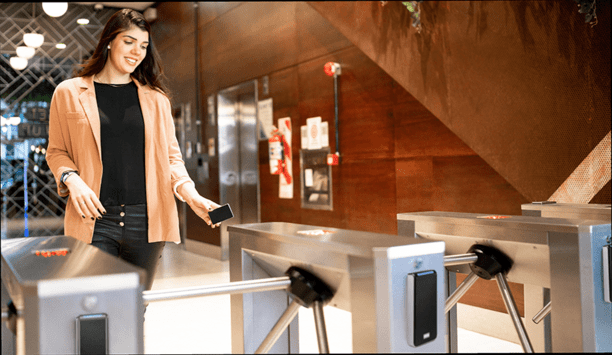
The truth behind 9 mobile access myths
Download
7 proven solutions for law enforcement key control and asset management
Download
Access control system planning phase 2
Download
Security practices for hotels
Download

